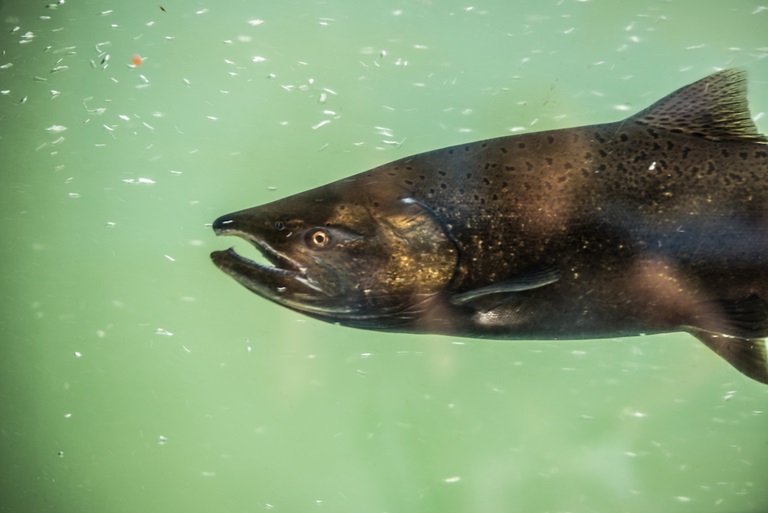DWR Teams with State, Federal Partners to Protect Endangered Species in SWP Waters
A salmon swims past a viewing window at the Feather River Fish Hatchery and fish barrier dam in Oroville, California
A team of DWR scientists are working with federal and state partners to embrace the challenge of overseeing the implementation of one of the most complex endangered species permits in California history.
The State Water Project (SWP) is operated by the Department of Water Resources (DWR) and delivers more than 3 million acre-feet of water a year to 27 million people. Operations of the SWP must be in compliance with the California Endangered Species Act (CESA) which conserves and protects endangered and threatened species.
CESA requires an Incidental Take Permit (ITP) to minimize, avoid and fully mitigate impacts from SWP operations to species designated as threatened or endangered. These species includes delta smelt, longfin smelt, winter-run Chinook salmon and spring-run Chinook salmon.
The ITP mandates a set of actions designed to mitigate for SWP impacts, including water export reductions, flow actions, new investments in science and monitoring activities, and habitat restoration. The ITP also mandates that DWR develop a robust adaptive management program. The adaptive management program will let new scientific information help to reduce uncertainty of key permit conditions. In short, the ITP provides the operational boundaries within which the SWP can plan, operate and manage its water storage and delivery while providing protection for state-listed endangered species.
Despite its complexity, the Department’s vision for ITP implementation has some simple initial steps and tenets.
First, DWR is committed to working closely with the Department of Fish and Wildlife (CDFW) to ensure that we meet our compliance milestones and that we are using the best available science to guide our implementation activities. Our scientists and regulatory teams have already set us in the right direction through some early successes in our implementation activities.
Second, DWR’s partnership with the State Water Contractors (SWC) will be equally important in our success, as we work toward a shared mission of providing water for homes, agricultural land and recreational uses while protecting and enhancing fish and wildlife. To this end, DWR is committed to implementing our ITP in a collaborative manner to ensure we maintain an open communication line with our SWC stakeholders. It is our hope DWR can build a strong partnership with CDFW and SWC to foster an environment that maximizes DWR’s ability to plan its water supply while applying top-notch science that will help reduce management uncertainty now and into the future. Together, we can be leaders in this new frontier of CESA compliance for the SWP.
DWR also recognizes the need to closely coordinate our implementation activities with those required of the US Bureau of Reclamation for federally-listed species. DWR is committed to working with Reclamation, National Marine Fisheries Service, and United States Fish and Wildlife Service to maximize efficiencies among our many coordinated activities, including those that require coordination with real-time operation monitoring groups and science and monitoring of endangered species. We have already had some early success with our federal partners including with restoration and science activities.
DWR just launched a new webpage for the ITP which will allow for increased communication and transparency with the public and stakeholders.
We plan to use this platform to showcase many of our key implementation activities carried out by a dedicated and talented team of scientists, operators and managers within DWR and with our state and federal partners.
California currently faces, and will continue to face, environmental and water supply challenges due to climate change and population growth. Through implementation of this ITP, we will provide novel solutions to help the State better manage our water supply and species protection measures well into the future.
